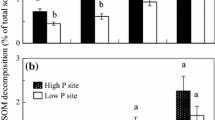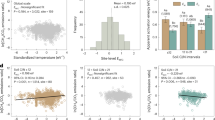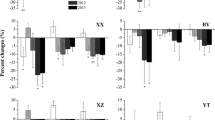Abstract
Organic matter decomposition regulates rates of carbon loss (CO2 and CH4) in wetlands and has implications for carbon sequestration in the context of changing global temperature. Here we determined the influence of temperature and vegetation type on both aerobic and anaerobic decomposition of organic matter in subtropical wetland soils. As in many other studies, increased temperature resulted in higher rates of respiration and methanogenesis under both aerobic and anaerobic conditions, and the positive effect of temperature depended on vegetation (source of carbon substrate to soil). Under anaerobic incubations, the proportion of gaseous C (CO2 and CH4) lost as CH4 increased with temperature indicating a greater sensitivity of methanogenesis to temperature. This was further supported by a wider range of Q10 values (1.4–3.6) for methane production as compared with anaerobic CO2 (1.3–2.5) or aerobic CO2 (1.4–2.1) production. The increasing strength of positive linear correlation between CO2:CH4 ratio and the soil organic matter ligno-cellulose index at higher temperature indicated that the temperature sensitivity of methanogenesis was likely the result of increased C availability at higher temperature. This information adds to our basic understanding of decomposition in warmer subtropical and tropical wetland systems and has implications for C models in wetlands with different vegetation types.





Similar content being viewed by others
References
Andersen JM (1976) An ignition method for determination of total phosphorus in lake sediments. Water Res 10:329–331
Arnold J, Corre MD, Veldkamp E (2008) Cold storage and laboratory incubation of intact soil cores do not reflect in situ nitrogen cycling rates of tropical forest soils. Soil Biol Biochem 40:2480–2483
Bardgett RD, Freeman C, Ostle NJ (2008) Microbial contributions to climate change through carbon cycle feedbacks. ISME J 2:805–814
Bartlett KB, Harriss RC (1993) Review and assessment of methane emissions from wetlands. Chemosphere 26:261–320
Bergman I, Klarqvist M, Nilsson M (2000) Seasonal variation in rates of methane production from peat of various botanical origins: effects of temperature and substrate quality. FEMS Microbiol Ecol 33:181–189
Bosatta E, Agren GI (1999) Soil organic matter quality interpreted thermodynamically. Soil Biol Biochem 31:1889–1891
Bridgham SD, Richardson CJ (1992) Mechanisms controlling soil respiration (CO2 and CH4) in southern peatlands. Soil Biol Biochem 24:1089–1099
Bridgham SD, Updegraff K, Pastor J (1998) Carbon, nitrogen, and phosphorus mineralization in northern wetlands. Ecology 79:1545–1561
Cadisch G, Giller KE (eds) (1997) Driven by nature. Plant litter quality and decomposition. CAB International, Wallingford, p 409
Cao MK, Gregson K, Marshall S (1998) Global methane emission from wetlands and its sensitivity to climate change. Atmos Environ 32:3293–3299
IPCC (Intergovernmental Panel on Climate Change) (2007) Climate change 2007: the physical science basis. In: Solomon S, Qin D, Manning M et al. (eds) Contribution of working group I to the fourth assessment report of the intergovernmental panel on climate change. Cambridge University Press, Cambridge, UK
Chanton JP, Whiting GJ, Happell JD, Gerard G (1993) Contrasting rates and diurnal patterns of methane emission from emergent aquatic macrophytes. Aquat Bot 46:111–128
Chin KJ, Conrad R (1995) Intermediary metabolism in methanogenic paddy soil and the influence of temperature. FEMS Microbiol Ecol 18:85–102
Chin KJ, Lukow T, Conrad R (1999) Effect of temperature on structure and function of the methanogenic archaeal community in an anoxic rice field soil. Appl Environ Microbiol 65:2341–2349
Conen F, Leifeld J, Seth B, Alewell C (2006) Warming mineralizes young and old soil carbon equally. Biogeosciences 3:515–519
Corstanje R, Reddy KR (2004) Response of biogeochemical indicators to a drawdown and subsequent reflood. J Environ Qual 33:2357–2366
DeBusk WF, Reddy KR (1998) Turnover of detrital organic carbon in a nutrient-impacted Everglades marsh. Soil Sci Soc Am J 62:1460–1468
Debusk WF, Reddy KR (2005) Litter decomposition and nutrient dynamics in a phosphorus enriched Everglades marsh. Biogeochemistry 75:217–240
Fang C, Moncrieff JB (2001) The dependence of soil CO2 efflux on temperature. Soil Biol Biochem 33:155–165
Fierer N, Craine JM, Mclauchlan K, Schimel JP (2005) Litter quality and the temperature sensitivity of decomposition. Ecology 86:320–326
Fierer N, Colman BP, Schimel JP, Jackson RB (2006) Predicting the temperature dependence of microbial respiration in soil: a continental-scale analysis. Global Biogeochem Cycles 20:GB3026
Fissore C, Giardina CP, Kolka RK, Trettin CC (2009) Soil organic carbon quality in forested mineral wetlands at different mean annual temperature. Soil Biol Biochem 41:458–466
Freeman C, Liska G, Ostle NJ, Jones SE, Lock MA (1995) The use of fluorogenic substrates for measuring enzyme-activity in peatlands. Plant Soil 175:147–152
Freeman C, Evans CD, Monteith DT, Reynolds B, Fenner N (2001) Export of organic carbon from peat soils. Nature 412:785
Freeman C, Fenner N, Ostle NJ et al (2004) Export of dissolved organic carbon from peatlands under elevated carbon dioxide levels. Nature 430:195–198
Fung I, John J, Lerner J, Matthews E, Prather M, Steele LP, Fraser PJ (1991) 3-Dimensional model synthesis of the global methane cycle. J Geophys Res 96:13033–13065
Grand M, Gaidos E (2010) Methane emission from a tropical Wetland in Ka’au Crater, O’ahu. Hawai’I Pacific Sci 64:57–72
Hein R, Crutzen PJ, Heimann M (1997) An inverse modeling approach to investigate the global atmospheric methane cycle. Global Biogeochem Cycles 11:43–76
Hines ME, Duddleston KN, Rooney-Varga JN, Fields D, Chanton JP (2008) Uncoupling of acetate degradation from methane formation in Alaskan wetlands: connections to vegetation distribution. Global Biogeochem Cycles 22:2017
Hogg EH, Lieffers VJ, Wein RW (1992) Potential carbon losses from peat profiles—effects of temperature, drought cycles, and fire. Ecol Appl 2:298–306
Ipsilantis I, Sylvia DM (2007) Abundance of fungi and bacteria in a nutrient impacted Florida wetland. Appl Soil Ecol 35:272–280
King GM, Berman T, Wiebe WJ (1981) Methane formation in the acidic peats of Okefenokee Swamp, Georgia. Am Midl Nat 105:386–389
Klinger LF, Zimmerman PR, Greenberg JP, Heidt LE, Guenther AB (1994) Carbon trace gas fluxes along a successional gradient in the Hudson-Bay lowland. J Geophys Res 99:1469–1494
Knoblauch C, Zimmermann U, Blumenberg M, Michaelis W, Pfeiffer EM (2008) Methane turnover and temperature response of methane-oxidizing bacteria in permafrost-affected soils of northeast Siberia. Soil Biol Biochem 40:3004–3013
Larionova AA, Zolotareva BN, Yevdokimov IV, Sapronov DV, Kuzyakov YV, Buegger F (2008) The rates of organic matter renewal in gray forest soils and chernozems. Eur Soil Sci 41:1378–1386
Leifeld J, Fuhrer J (2005) The temperature response of CO2 production from bulk soils and soil fractions is related to soil organic matter quality. Biogeochemistry 75:433–453
Liski J, Ilvesniemi H, Makela A, Westman CJ (2000) Temperature dependence of old soil organic matter. Ambio 29:56–57
Lloyd J, Taylor JA (1994) On the temperature-dependence of soil respiration. Func Ecol 8:315–323
Lovley DR, Klug MJ (1983) Sulfate reducers can out-compete methanogens at fresh-water sulfate concentrations. Appl Environ Microbiol 45:187–192
Matthews E, Fung I (1987) Methane emission from natural wetlands: global distribution, area and environmental characteristics of sources. Global Biogeochem Cycles 1:61–86
McKenzie C, Schiff S, Aravena R, Kelly C, St. Louis V (1998) Effect of temperature on production of CH4 and CO2 from Peat in a Natural and Flooded Boreal Forest Wetland. Clim Change 40:247–266
McLatchey GP, Reddy KR (1998) Regulation of organic matter decomposition and nutrient release in a wetland soil. J Environ Qual 27:1268–1274
McNamara NP, Plant T, Oakley S, Ostle NJ (2008) Gully hotspot contribution to landscape methane and carbon dioxide fluxes in a northern peatland. Sci Total Environ 404:354–360
Melillo JM, Aber JD, Linkins AE, Ricca A, Fry B, Nadelhoffer KJ (1989) Carbon and nitrogen dynamics along the decay continuum—plant litter to soil organic-matter. Plant Soil 115:189–198
Mitra S, Wassmann R, Vlek PLG (2005) An appraisal of global wetland area and its carbon stock. Curr Sci 88:25–34
Moore TR, Dalva M (1993) The influence of temperature and water table position on carbon dioxide and methane emissions from laboratory columns of peatland soils. J Soil Sci 44:651–664
Moore TR, Dalva M (1997) Methane and carbon dioxide exchange potentials of peat soils in aerobic and anaerobic laboratory incubations. Soil Biol Biochem 29:1157–1164
Morrissey LA, Livingston GP (1992) Methane emissions from Alaska Arctic tundra: an assessment of local spatial variability. J Geophy Res 97:16661–16670
Page SE, Rieley JO, Banks CJ (2010) Global and regional importance of the tropical peatland carbon pool. Global Change Biol. doi:10.1111/j.1365-2486.2010.02279.x
Phelps TJ, Zeikus JG (1985) Effect of fall turnover on terminal carbon metabolism in Lake Mendota sediments. Appl Environ Microbiol 50:1285–1291
Raich JW, Schlesinger WH (1992) The global carbon dioxide flux in soil respiration and its relationship to vegetation and climate. Tellus 44:81–99
Reddy R, DeLaune RD (2008) Biogeochemistry of wetlands: science and applications. Taylor and Francis group LLC, Boca Raton
Reichstein M, Subke J-A, Angeli AC, Tenhunen JD (2005) Does the temperature sensitivity of decomposition of soil organic matter depend upon water content, soil horizon, or incubation time? Global Change Biol 11:1754–1767
Rey A, Jarvis P (2006) Modelling the effect of temperature on carbon mineralization rates across a network of European forest sites (FORCAST). Global Change Biol 12:1894–1908
Rooney-Varga JN, Giewat MW, Duddleston KN, Chanton JP, Hines ME (2007) Links between archaeal community structure, vegetation type and methanogenic pathway in Alaskan peatlands. FEMS Microbiol Ecol 60:240–251
Rowland AP, Roberts JD (1994) Lignin and cellulose fractionation in decomposition studies using acid-detergent fiber methods. Commun Soil Sci Plant Anal 25:269–277
Scanlon D, Moore T (2000) Carbon dioxide production from peatland soil profiles: the influence of temperature, oxic/anoxic conditions and substrate. Soil Sci 165:153–160
Schipper LA, Reddy KR (1994) Methane production and emissions from four reclaimed and Pristine Wetlands of Southeastern United States. Soil Sci Soc Am J 58:1270–1275
Segers R (1998) Methane production and methane consumption: a review of processes underlying wetland methane fluxes. Biogeochemistry 41:23–51
Seo M (2002) Influence of nutrients, vegetation types and seasonality on microbial activities of carbon in a subtropical wetland, Masters Thesis. University of Florida, Gainesville, FL
Shaver GR, Giblin AE, Nadelhoffer KJ, Thieler KK, Downs MR, Laundre JA, Rastetter EB (2006) Carbon turnover in Alaskan tundra soils: effects of organic matter quality, temperature, moisture and fertilizer. J Ecol 94:740–753
Shindell DT, Faluvegi G, Koch DM, Schmidt GA, Unger N, Bauer SE (2009) Improved attribution of climate forcing to emissions. Science 326:716–718
Smemo KA, Yavitt JB (2006) A multi-year perspective on methane cycling in a shallow peat fen in central New York State, USA. Wetlands 26:20–29
Strom L, Mastepanov M, Christensen TR (2005) Species-specific effects of vascular plants on carbon turnover and methane emissions from wetlands. Biogeochemistry 75:65–82
Teh YA, Silver WL (2006) Effects of soil structure destruction on methane production and carbon partitioning between methanogenic pathways in tropical rain forest soils. J Geophyl Res-Biogeo, 111, G01003, 1–8. doi:10.1029/2005JG000020
Updegraff K, Pastor J, Bridgham SD, Johnston CA (1995) Environmental and substrate controls over carbon and nitrogen mineralization in northern wetlands. Ecol Appl 5:151–163
USEPA (1993) Methods for chemical analysis of water and wastes. Environmental Monitoring Support Lab, Cincinnati, OH
Valentine DW, Holland EA, Schimel DS (1994) Ecosystem and physiological controls over methane production in northern wetlands. J Geophys Res 99:1563–1571
Goering HK, Van Soest, PJ (1970). Forage fiber analysis (apparatus, reagents, procedures and some applications). In: Agriculture Handbook No. 379. Agriculture Research Service, United States Department of Agriculture, Washington, USA
Whiting GJ, Chanton JP (1993) Primary production control of methane emission from wetlands. Nature 364:794–795
Wickland KP, Neff JC (2008) Decomposition of soil organic matter from boreal black spruce forest: environmental and chemical controls. Biogeochemistry 87:29–47
Winkler JP, Cherry RS, Schlesinger WH (1996) The Q10 relationship of microbial respiration in a temperate forest soil. Soil Biol Biochem 28:1067–1072
Wright AL, Reddy KR (2001) Heterotrophic microbial activity in northern Everglades wetland soils. Soil Sci Soc Am J 65:1856–1864
Yavitt JB, Lang GE (1990) Methane production in contrasting wetland sites: response to organic-chemical components of peat and to sulfate reduction. Geomicrobiol J 8:27–46
Yavitt JB, Williams CJ, Wieder RK (1997) Production of methane and carbon dioxide in peatland ecosystems across North America: effects of temperature, aeration, and organic chemistry of peat. Geomicrobiol J 14:299–316
Zak DR, Holmes WE, MacDonald NW, Pregitzer KS (1999) Soil temperature, matric potential, and the kinetics of microbial respiration and nitrogen mineralization. Soil Sci Soc Am J 63:575–584
Acknowledgments
This work was supported by funding from the St Johns River water management district, Palatka, Florida. We sincerely appreciate the critical reviews provided by the anonymous reviewers, which greatly improved the overall quality of our paper.
Author information
Authors and Affiliations
Corresponding author
Rights and permissions
About this article
Cite this article
Inglett, K.S., Inglett, P.W., Reddy, K.R. et al. Temperature sensitivity of greenhouse gas production in wetland soils of different vegetation. Biogeochemistry 108, 77–90 (2012). https://doi.org/10.1007/s10533-011-9573-3
Received:
Accepted:
Published:
Issue Date:
DOI: https://doi.org/10.1007/s10533-011-9573-3




